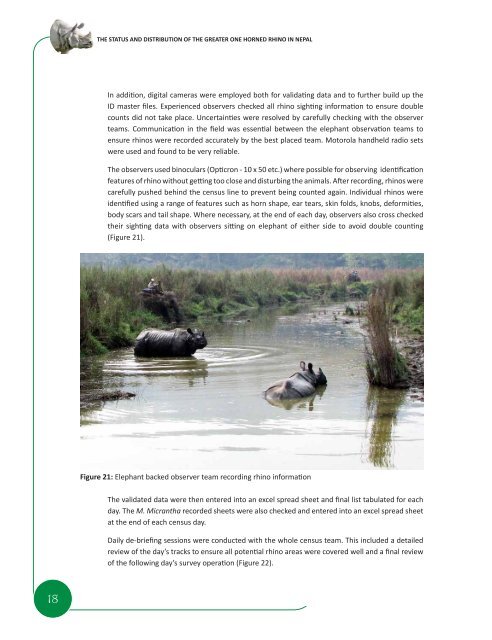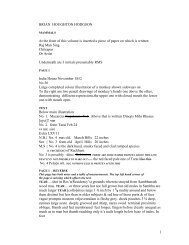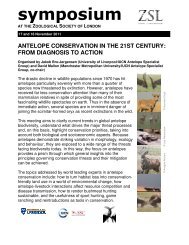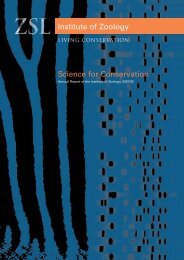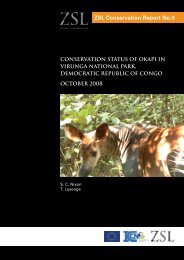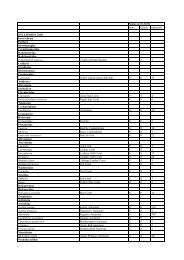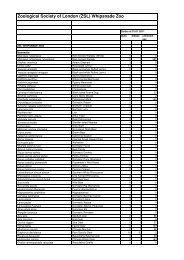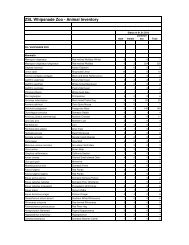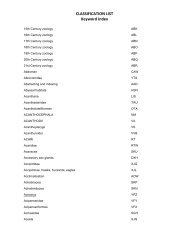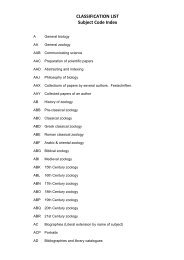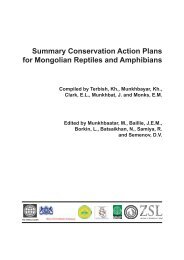the status and distribution of the greater one-horned rhino in nepal
the status and distribution of the greater one-horned rhino in nepal
the status and distribution of the greater one-horned rhino in nepal
You also want an ePaper? Increase the reach of your titles
YUMPU automatically turns print PDFs into web optimized ePapers that Google loves.
18<br />
THE STATUS AND DISTRIBUTION OF THE GREATER ONE HORNED RHINO IN NEPAL<br />
In additi on, digital cameras were employed both for validati ng data <strong>and</strong> to fur<strong>the</strong>r build up <strong>the</strong><br />
ID master fi les. Experienced observers checked all <strong>rh<strong>in</strong>o</strong> sighti ng <strong>in</strong>formati on to ensure double<br />
counts did not take place. Uncerta<strong>in</strong>ti es were resolved by carefully check<strong>in</strong>g with <strong>the</strong> observer<br />
teams. Communicati on <strong>in</strong> <strong>the</strong> fi eld was essenti al between <strong>the</strong> elephant observati on teams to<br />
ensure <strong>rh<strong>in</strong>o</strong>s were recorded accurately by <strong>the</strong> best placed team. Motorola h<strong>and</strong>held radio sets<br />
were used <strong>and</strong> found to be very reliable.<br />
The observers used b<strong>in</strong>oculars (Opti cron - 10 x 50 etc.) where possible for observ<strong>in</strong>g identi fi cati on<br />
features <strong>of</strong> <strong>rh<strong>in</strong>o</strong> without getti ng too close <strong>and</strong> disturb<strong>in</strong>g <strong>the</strong> animals. Aft er record<strong>in</strong>g, <strong>rh<strong>in</strong>o</strong>s were<br />
carefully pushed beh<strong>in</strong>d <strong>the</strong> census l<strong>in</strong>e to prevent be<strong>in</strong>g counted aga<strong>in</strong>. Individual <strong>rh<strong>in</strong>o</strong>s were<br />
identi fi ed us<strong>in</strong>g a range <strong>of</strong> features such as horn shape, ear tears, sk<strong>in</strong> folds, knobs, deformiti es,<br />
body scars <strong>and</strong> tail shape. Where necessary, at <strong>the</strong> end <strong>of</strong> each day, observers also cross checked<br />
<strong>the</strong>ir sighti ng data with observers sitti ng on elephant <strong>of</strong> ei<strong>the</strong>r side to avoid double counti ng<br />
(Figure 21).<br />
Figure 21: Elephant backed observer team record<strong>in</strong>g <strong>rh<strong>in</strong>o</strong> <strong>in</strong>formati on<br />
The validated data were <strong>the</strong>n entered <strong>in</strong>to an excel spread sheet <strong>and</strong> fi nal list tabulated for each<br />
day. The M. Micrantha recorded sheets were also checked <strong>and</strong> entered <strong>in</strong>to an excel spread sheet<br />
at <strong>the</strong> end <strong>of</strong> each census day.<br />
Daily de-briefi ng sessions were conducted with <strong>the</strong> whole census team. This <strong>in</strong>cluded a detailed<br />
review <strong>of</strong> <strong>the</strong> day’s tracks to ensure all potenti al <strong>rh<strong>in</strong>o</strong> areas were covered well <strong>and</strong> a fi nal review<br />
<strong>of</strong> <strong>the</strong> follow<strong>in</strong>g day’s survey operati on (Figure 22).


